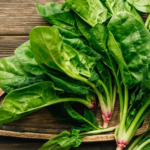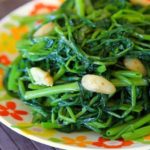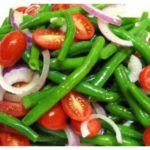Have you ever dined out and wondered how restaurants manage to stir-fry vegetables that look so vibrant and glossy? Not only do they look appealing, but these dishes also offer a perfect balance of tenderness and sweetness. However, recreating this dish at home is not as simple as it seems. The following tips will help you master the art of stir-frying vegetables like a pro, ensuring that your dish will be the first to disappear from the dinner table.

While various types of vegetables can be stir-fried, the most popular choices are water spinach and leafy greens from the Brassica family, such as Chinese cabbage, Chinese broccoli, and bok choy. To create a delicious stir-fried vegetable dish, start by selecting fresh and high-quality ingredients. Opt for greens with vibrant, young leaves, free from any yellowing or damage. Once you’ve cleaned and trimmed the vegetables, cut them into bite-sized pieces, and for those with thicker stems, make sure to split them for even cooking.
1. The first secret to delicious stir-fried vegetables is to ensure they are completely dry.
If the vegetables are wet, they will become soggy and lose their crispness during cooking. To speed up the drying process, you can place them in a colander and give it a good spin, or use paper towels to blot away the moisture.

2. Prepare all the ingredients before stir-frying.
For instance, crush some garlic and place it in a separate bowl. Also, make sure your sauce is ready. As stir-frying involves quick cooking over high heat, it’s crucial to have all your ingredients prepared and within easy reach.
3. The golden rule of stir-frying vegetables is to cook them for 3 minutes over high heat.
Start by heating your wok or pan over the highest heat setting. To test if it’s hot enough, sprinkle a few drops of water into the pan; if the water sizzles and evaporates within 1-2 seconds, your pan is ready for action. Be careful not to overheat the pan.
Move the pan away from the heat source and add oil: Pull the pan off the heat and add a tablespoon of oil. Lift the pan and tilt it to coat the bottom and sides evenly. (If the oil starts smoking as soon as you pour it in, your pan is too hot. Remove it from the heat and let it cool down for a few minutes).
Add garlic and chili (if using), and sauté for 10 seconds or until fragrant.
Put in the vegetables: Push the garlic to the side of the pan and add your veggies.
Season the vegetables: Sprinkle salt and pepper over the vegetables.

Set a timer for 2 minutes: This is especially helpful for beginners, as it gives you an idea of the cooking time and helps you understand how long the vegetables need to cook. However, the ultimate decision on doneness depends on your preference for texture and taste. From this point on, the vegetables will cook for approximately 2 to 2.5 minutes.
Stir-fry for 1 minute: Continue stir-frying for 1 minute or until the vegetables start to wilt.
Add the sauce: Pour the sauce mixture around the edges of the pan instead of directly into the center (this prevents the pan from cooling down and reduces the cooking temperature). Stir and toss to coat the vegetables with the sauce.
Cover and cook for 15 seconds.
Uncover and stir-fry: Remove the lid and continue stir-frying for 30 to 60 seconds or until the vegetables are tender.
Only stir-fry a handful of vegetables at a time, ensuring they fit comfortably in your pan. Overcrowding the pan makes it difficult to toss the vegetables evenly, resulting in uneven cooking and an unappetizing appearance.

Good luck, and happy cooking!
Source: Pháp luật và bạn đọc
The more mature the vegetables are cooked, the higher the nutrient content, children who consume them grow taller and stronger.
 vegetables are cooked, the higher the nutrient content, children who consume them grow taller and stronger.’>
vegetables are cooked, the higher the nutrient content, children who consume them grow taller and stronger.’>There are some types of vegetables that can be eaten raw and still provide the same nutritional value as they originally have. However, there are some types that need to be cooked thoroughly, even cooked well in order to fully utilize their benefits.
Should you cover or uncover the pot when stir-frying or boiling vegetables? This is crucial for a delicious and safe meal.
Opening or closing a food container not only affects the aesthetics and quality of the food, but also relates to health safety.





































